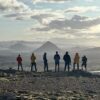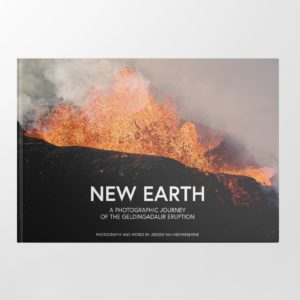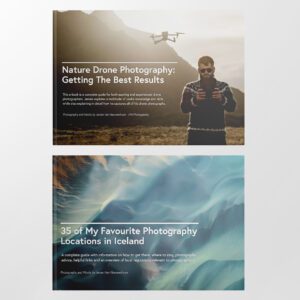After returning from the epic expedition to Antarctica, it was time to move onto part two of my three and a half week journey. Because the Antarctica expedition started and ended in Punta Arenas (Chile), we decided to add on Chilean Patagonia for several days and, more specifically, Torres Del Paine National Park. Even though that part of the journey got cut short by a few days due to the unusual ending to the Antarctica expedition, I was looking forward to finally seeing a glimpse of Patagonia, which has been a long-time bucket list location for me.
Shot at 500mm with my Canon EOS R5 and Canon RF 100-500mm, I really enjoyed this particular view of the low clouds veiling the trees and mountainsides.
Replacing One Epic Photography Location With Another
After the Antarctica expedition, some of us professional photographers leading the expedition decided to add on a little epilogue by travelling to Torres Del Paine National Park in Chile. Considering we had already travelled halfway across the globe, and the drive from Punta Arenas to Torres Del Paine only takes a few hours, it seemed like the logical thing to do. Originally, we were to spend 7 days in Torres Del Paine but due to the unexpected ending to the Antarctica expedition, we were forced to change our plans.
However, as soon as we landed in Punta Arenas, we picked up our two rental cars and set off north to Puerto Natales. The drive there was quite boring and long. It’s essentially a 250 kilometre straight road with an occasional bend to keep you on your toes. Throughout the entire drive I kept wondering one thing: “Where are the mountains?!”. I am not sure what I was expecting exactly but I had this idea that the massive mountains of the Southern Andes would be visible from really far away. Especially when you consider how flat the entire area north of Punta Arenas is.
To clarify: while Patagonia has been on my list for ages, I didn’t really want to deep dive into researching locations or looking at other people’s work to get inspired. The reason for that is that I didn’t want to be ‘infected’ with ideas. That way I would look at everything through my own eyes. I handled it the same way with the Antarctica expedition and I really felt it was the perfect decision to get the best outcome.
Once we arrived in Puerto Natales, we fuelled up and bought an extra jerrycan of gas for each car. The reason we did that is because Puerto Natales is the closest fuel pump to where we were headed. There is quite literally no chance to fuel up anywhere else within or near Torres Del Paine. After another hour and a half of driving on a dirt road, we arrived at Rio Serrano. Rio Serrano is a kind of ‘oasis’ right at the edge of the Torres Del Paine National Park.

The first view of Torres Del Paine National Park from the lookout point at Rio Serrano. I captured this image on my view as I couldn’t be bothered to take my camera gear. We were pretty eager to settle down at our base of operations for the next days.
Our base of operations during our time would be the excellent Rio Serrano Hotel + Spa. While I don’t have much experience with hotels in Torres Del Paine, I can attest that the Rio Serrano Hotel + Spa couldn’t have been a better base of operations to me. Not only is it the perfect place to relax after a long day of hiking & shooting thanks to the spa, but they also had incredible food. Perhaps the best part of it was that the restaurant staff was incredibly helpful in adjusting dinner reservations to accommodate us photographers. The restaurant manager was especially helpful in making sure we had the best time while also having the best shooting opportunities. And if that wasn’t enough: it’s also about the location. From within many of the rooms, you get an epic view towards the famous mountain range. Especially from within the bar and dining room, thanks to the huge windows, you get to look out onto the epic scenery.

The view from the Rio Serrano Hotel + Spa was simply stunning. Especially the view from the dining room was exceptional.

The food was top notch and I had several great meals at the hotel.

When the weather wasn’t great, you could relax at in the spa which is available inside the hotel.
Laid Back Exploration Of Torres Del Paine National Park
After the long drive and settling in at Rio Serrano, I began realising I may have been suffering from a ‘photography burnout’. Even though I was at one of my bucket list photography locations in the world, I felt without a drive to photograph, low on energy and uninspired. I guess it was normal after having been to one of the rawest locations on the planet.
Because no one in our group had done any planning, we decided to take things as they came and go about it more relaxed. On our first morning, we started off with a sunrise session at one of the classic locations before heading deeper into Torres Del Paine National Park. This would be the ‘plan’ pretty much every day: start out with a sunrise session and explore a few other areas within the park. We arrived about 30 minutes before the first glimpse of sunrise would begin to show. I really struggled. I couldn’t find a spot to shoot from that I was happy with and felt I could have used a bit more time scouting beforehand. After sunrise had gone, I explored lower down to find different angles but unfortunately my struggle continued. It may sound strange, but I am not used to photographing trees at all as most places I photograph at simply don’t have any. That meant I had to really ‘rewire’ my brain.

I really struggled that first morning to find a good vantage point and didn’t really manage to get anything I was very happy with. The time pressure of it being right before sunrise didn’t help either. This particular frame was probably the best outcome from that session.
The Fieriest Of Skies
It was the second morning when we really saw what Torres Del Paine was about. We decided to split up, spreading ourselves between two locations for sunrise. I decided to go back to the same sunrise location as the day before. That meant going into sunrise with a good idea of what to expect on location so I felt better prepared going into the shoot. I set up my gear at the viewpoint I enjoyed most the day before.
First light began promising, colouring the mountains in a purple shade, but soon after the light became incredibly flat as it was quite cloudy. After about 20 minutes, it seemed as if the light would not return as it became more and more cloudy. The promising start of the morning had all but disappeared. But then, everything began changing. I started as I packed up my gear. Suddenly, we spotted two pumas running past our parked car. I couldn’t believe it! While they were too far away, and it was too dark to actually photograph them, it was nonetheless an incredible feeling to witness these wild cats in their habitat. Shortly after that moment, the sky began lighting up as if there was a massive fire starting above us. The sky turned pink, then orange and finally fiery red. It was incredible but also so unexpected to me! I had essentially already given up but suddenly, it seemed as if someone turned the sky up to eleven. I frantically got my camera back out of my backpack and didn’t even bother setting up my tripod and just began shooting.
It’s All About The Mountains
Torres Del Paine National Park wasn’t at all how I imagined it to be. Somehow I had imagined that there would be high peaks everywhere in the area, and the mountain range you see in all the images was just the most iconic. But it isn’t like that at all. It really is all about the same mountains. Essentially, a large amount of the shots taken in Torres Del Paine (read this with a grain of salt) are somehow using the same mountains but with different foregrounds. And while I really did get the impression that ‘it’s just one of those places’, perhaps this is also my own fault for not doing better research beforehand, or because I just came from Antarctica.
Don’t get me wrong: the iconic mountain range of Torres Del Paine is stunningly epic but to me it felt really hard to be creative and to ‘freestyle’. Where the real difference in my shots lie, is in changing weather conditions, different light and the occasional wildlife for scale. I didn’t really feel there was much else to shoot and I quickly felt I had ‘seen’ the area.
The Challenges Of Torres Del Paine
But there was another element contributing to that feeling that I had ‘seen’ it: the limitations of Torres Del Paine National Park. Coming from Iceland, I am used to ‘free roaming’ when it comes to nature. That means you can quite literally walk wherever you want as long as it’s uncultivated land and it isn’t closed off for the purpose of nature protection. In Torres Del Paine, you always have to stay on the premade trails. This severely limits the perspectives and angles you can shoot from. One way you could get around that limitation is by using a drone but, perhaps unfortunately, drones are banned from the national park too. Additionally, whilst driving, the lay-bys are not exactly numerous, and you are not allowed to stop along the road, which means you are usually just driving from one tourist ‘hotspot’ to another. Finally, another challenge is that some hiking trails are being closed during the night which means some locations are not accessible for sunrise or sunset shoots depending on what time of year you visit Torres Del Paine.
You could argue that perhaps these rules shouldn’t be taken too literally but unfortunately, that is not the case. To illustrate with one example… At one point, I saw a few tourists sit on a big boulder next to the trail. Soon after they sat down, two guides who passed by immediately told them off and urged them to get back on the trail. Witnessing that, I proceeded to sit down on the trail, in everyone’s way, because I really wanted to take my time to photograph a condor flying around the peaks. Doing that, just so I would not break any rules. It seemed a bit unusual to me and felt very restrictive.
And again, don’t misunderstand me: I have the utmost respect for the rules and regulations. However, these rules did make me feel very restricted in terms of photography. It’s possible that more can be achieved by doing the longer treks in the area (also along designated trails) but I can’t comment on that.

Nigel Danson took this photograph of me while exploring the swamps around Rio Serrano. I am looking directly at Torres Del Paine.

One of the mornings, I didn’t feel like heading out but still managed to capture some good light near the hotel.
Conclusion
Besides all of these restrictive rules, I had a really great time and came home with several shots I am very proud of. Did I miss out by our Patagonia visit being cut short? No, not at all. Should you visit Torres Del Paine? 100% YES! That said, for me personally, I don’t feel like I will visit Torres Del Paine again any time soon. However, I am glad I managed to see it for myself and tick it off my (photography) bucket list.
What has piqued my interest though, is Argentinian Patagonia, which I have heard has many more possibilities. Perhaps in 2026…
Support Jeroen’s Work
As an independent photographer, Jeroen partially relies on your support to keep producing worthwhile content such as blogs, photographs, books and much more. If you want to support his work, it is possible to do so by buying his e-books & books, prints or calendars.
You can also sign up to the newsletter to stay up to date on new blog posts, projects, workshops and other interesting information.
Thank you for considering!





























Thank you for capturing the beauty of Patagonia, and its harshness.